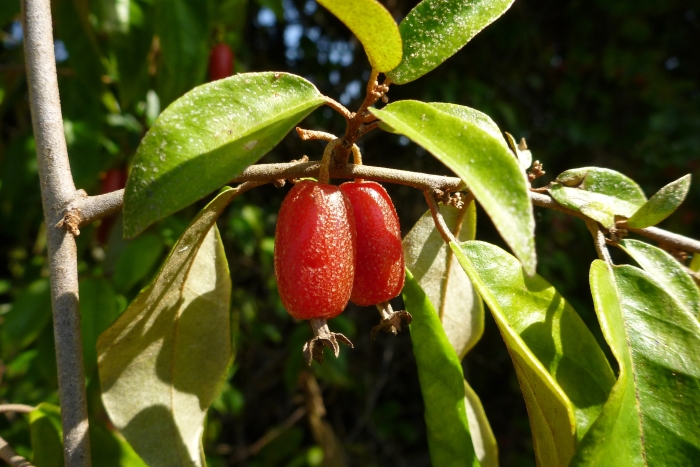Millaa Millaa
(Elaeagnus triflora)
Millaa Millaa (Elaeagnus triflora)
/
/

coenobita
CC BY 4.0
Image By:
coenobita
Recorded By:
Copyright:
CC BY 4.0
Copyright Notice:
Photo by: coenobita | License Type: CC BY 4.0 | License URL: http://creativecommons.org/publicdomain/zero/1.0/deed.en | Uploader: Junglenut | Publisher: Wikimedia Commons |































Estimated Native Range
Summary
Elaeagnus triflora, commonly known as Millaa Millaa, is an evergreen shrub or small tree native to open woodlands and forest edges in Southeast Asia and Australia. It typically grows to a height of 8-12 feet (2.4-3.7 meters) and a width of 6-8 feet (1.8-2.4 meters). The plant features dense foliage and can be recognized by its silvery scales on the underside of the leaves. Elaeagnus triflora produces fragrant flowers that are yellow on the inside with silver and white scales on the outside, blooming in the summer. The flowers are small but numerous, adding a subtle ornamental value. After flowering, it bears edible fruits that are popular with birds and other wildlife.
Millaa Millaa is valued for its ability to thrive in a variety of conditions, making it a versatile choice for gardeners. It is often used for hedging, screening, and as a windbreak due to its dense growth habit. Additionally, it can serve as a host plant for nitrogen-fixing bacteria, which can improve soil fertility. In cultivation, it prefers part shade but can tolerate full sun in cooler climates. It requires medium amounts of water and grows best in soils with medium to fast drainage. Gardeners should be aware of its potential to spread and become invasive outside its native range. It is advisable to plant Elaeagnus triflora with caution and to monitor its growth to prevent unwanted spread.CC BY-SA 4.0
Millaa Millaa is valued for its ability to thrive in a variety of conditions, making it a versatile choice for gardeners. It is often used for hedging, screening, and as a windbreak due to its dense growth habit. Additionally, it can serve as a host plant for nitrogen-fixing bacteria, which can improve soil fertility. In cultivation, it prefers part shade but can tolerate full sun in cooler climates. It requires medium amounts of water and grows best in soils with medium to fast drainage. Gardeners should be aware of its potential to spread and become invasive outside its native range. It is advisable to plant Elaeagnus triflora with caution and to monitor its growth to prevent unwanted spread.CC BY-SA 4.0
Plant Description
- Plant Type: Tree, Shrub
- Height: 8-12 feet
- Width: 6-8 feet
- Growth Rate: Rapid
- Flower Color: Yellow, White
- Flowering Season: Summer
- Leaf Retention: Evergreen
Growth Requirements
- Sun: Part Shade
- Water: Medium
- Drainage: Medium, Fast
Common Uses
Bank Stabilization, Bee Garden, Bird Garden, Butterfly Garden, Deer Resistant, Drought Tolerant, Edible*Disclaimer: Easyscape's listed plant edibility is for informational use. Always verify the safety and proper identification of any plant before consumption., Fragrant, Salt Tolerant
Natural Habitat
Native to open woodlands and forest edges in Southeast Asia and Australia
Other Names
Common Names: Millaa-Millaa Vine, Millaa-Vine, 菲律賓胡頹子
Scientific Names: , Elaeagnus latifolia, Elaeagnus philippinensis, Elaeagnus triflora, Elaeagnus philippensis, Elaeagnus ferruginea, Elaeagnus cumingii, Elaeagnus rigida, Elaeagnus ferruginea var. atrovirens, Elaeagnus perrottetii
GBIF Accepted Name: Elaeagnus triflora Roxb.